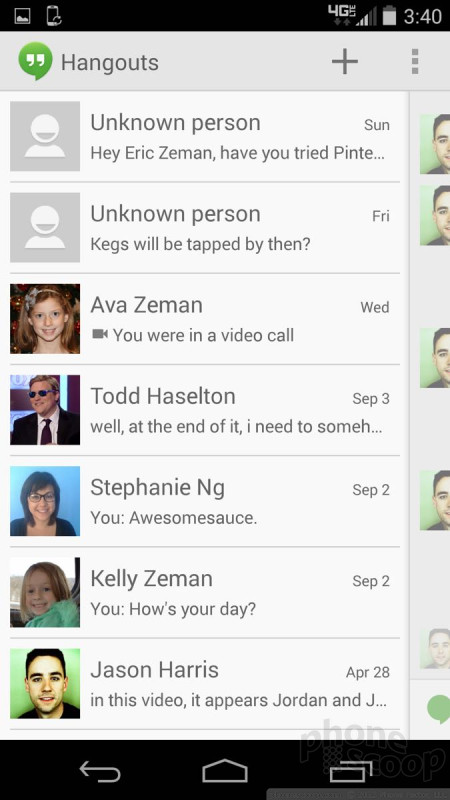Review: Motorola Moto X for Verizon Wireless
Menus
The Moto X runs a nearly unmolested version of Android 4.4 KitKat. It will be one of the first wave of handsets to receive the Android L release, which is expected later this year. The phone also comes with the extensive suite of apps developed by Motorola to make the device more useful and usable.
The lock screen has been modified with what Motorola calls Active Display. Active Display brings the clock and notifications to the screen (when it is locked and off) without turning on the whole display. Instead, it only shows the time and select icons in white on a black screen. You don't have to push any buttons to check the time or see if you have any new emails. If the X is sitting on a desk, it will automatically light up the Active Display when a new email or message arrives. It will then pulse on and off with that notification until dismissed. Active Display will turn on when you nudge the X, when you turn it over, when you pull it out of your pocket or bag, when you shake it, and pretty much any time you move the phone. It will also turn on if you wave your hand over the phone or even simply reach for it. It's really, really useful and works whether or not you have a password.
The rest of the menus operate exactly as they do on any KitKat phone. There are minimal home screens active out of the box, and they aren't littered with widgets and shortcuts. In other words, it takes only a few moments to customize the panels to suit your own needs. The app menu is laid out in a clean grid. Apps are listed alphabetically, but you can drop them into folders if you want. There's no list view.
The settings menu is the same old white-text-on-black-screen we've seen from Android for several years now. Motorola hasn't dressed it up at all. It is simple and straight-forward to use. Similarly, the notification shade is devoid of extras like toggles for the radios. Instead, it offers only notifications and access to the control panel.
Motorola soldered a quad-core Snapdragon 801 processor onto the Moto X's motherboard, which provides plenty of power to get things done. I didn't see any lag problems, or anything else troublesome. The Moto X is a quick phone and performs well.
Calls and Contacts
Pressing the phone button on the home screen brings you to the stock phone app. You can swipe sideways to access the call log, and your favorite contacts. The call log provides some information about calls (time, duration) in addition to shortcuts for redialing or sending a text message to that number.
Contacts are automatically synced with your Google accounts and whatever other contact databases you might wish. Contact cards — or direct dial or direct message shortcuts — can be placed on the home screens, which give you instant access to your besties. You can also add contacts to your Favorites list, which is visible in the phone app and includes a homescreen widget. These standard Android calling and contact apps function well enough, though I find they aren't as intuitive as they could be.
Messaging
The Moto X comes with the same stock Android communications apps that are on every other Android device. That means Gmail, email, messaging, Hangouts, and Google+.
Verizon Messaging is set as the default messaging application and it handles SMS/MMS. Verizon Messaging offers access to some neat extras. For example, it includes its own set of animated emoticons. The app can be used to create a postcard, as well as to record a voice message or send your location via Glympse. Beyond these tools, the functionality of Verizon Messaging is OK, but I find it lacks polish. It also lacks templates with pre-composed messages.
If you don't like Verizon Messaging, you can set either the plain Messaging app or the Hangouts app to handle SMS/MMS functionality. Google recently updated Hangouts to include some Google Voice messaging functions. The latest version is a bit sloppy and confusing. (It's not as intuitive as it used to be. Google can do better.) There are no social networks preinstalled, so you have to snag Facebook and Twitter on your own.
























 Hands On with the New Moto X
Hands On with the New Moto X
 Motorola Turns Moto X Into True Flagship
Motorola Turns Moto X Into True Flagship
 Motorola Moto X (CDMA, 2nd gen.)
Motorola Moto X (CDMA, 2nd gen.)




